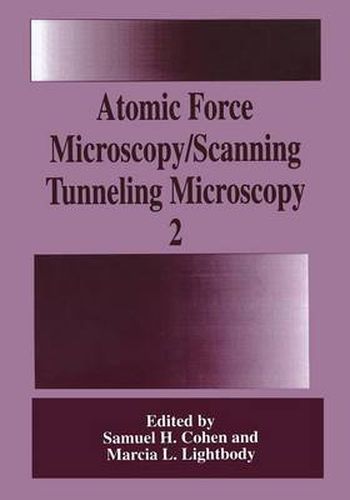Readings Newsletter
Become a Readings Member to make your shopping experience even easier.
Sign in or sign up for free!
You’re not far away from qualifying for FREE standard shipping within Australia
You’ve qualified for FREE standard shipping within Australia
The cart is loading…






This title is printed to order. This book may have been self-published. If so, we cannot guarantee the quality of the content. In the main most books will have gone through the editing process however some may not. We therefore suggest that you be aware of this before ordering this book. If in doubt check either the author or publisher’s details as we are unable to accept any returns unless they are faulty. Please contact us if you have any questions.
This book represents the compilation of papers presented at the second Atomic Force Microscopy/Scanning Tunneling Microscopy (AFM/STM) Symposium, held June 7 to 9, 1994, in Natick, Massachusetts, at Natick Research, Development and Engineering Center, now part ofU.S. Army Soldier Systems Command. As with the 1993 symposium, the 1994 symposium provided a forum where scientists with a common interest in AFM, STM, and other probe microscopies could interact with one another, exchange ideas and explore the possibilities for future collaborations and working relationships. In addition to the scheduled talks and poster sessions, there was an equipment exhibit featuring the newest state-of-the-art AFM/STM microscopes, other probe microscopes, imaging hardware and software, as well as the latest microscope-related and sample preparation accessories. These were all very favorably received by the meeting’s attendees. Following opening remarks by Natick’s Commander, Colonel Morris E. Price, Jr., and the Technical Director, Dr. Robert W. Lewis, the symposium began with the Keynote Address given by Dr. Michael F. Crommie from Boston University. The agenda was divided into four major sessions. The papers (and posters) presented at the symposium represented a broad spectrum of topics in atomic force microscopy, scanning tunneling microscopy, and other probe microscopies.
$9.00 standard shipping within Australia
FREE standard shipping within Australia for orders over $100.00
Express & International shipping calculated at checkout
This title is printed to order. This book may have been self-published. If so, we cannot guarantee the quality of the content. In the main most books will have gone through the editing process however some may not. We therefore suggest that you be aware of this before ordering this book. If in doubt check either the author or publisher’s details as we are unable to accept any returns unless they are faulty. Please contact us if you have any questions.
This book represents the compilation of papers presented at the second Atomic Force Microscopy/Scanning Tunneling Microscopy (AFM/STM) Symposium, held June 7 to 9, 1994, in Natick, Massachusetts, at Natick Research, Development and Engineering Center, now part ofU.S. Army Soldier Systems Command. As with the 1993 symposium, the 1994 symposium provided a forum where scientists with a common interest in AFM, STM, and other probe microscopies could interact with one another, exchange ideas and explore the possibilities for future collaborations and working relationships. In addition to the scheduled talks and poster sessions, there was an equipment exhibit featuring the newest state-of-the-art AFM/STM microscopes, other probe microscopes, imaging hardware and software, as well as the latest microscope-related and sample preparation accessories. These were all very favorably received by the meeting’s attendees. Following opening remarks by Natick’s Commander, Colonel Morris E. Price, Jr., and the Technical Director, Dr. Robert W. Lewis, the symposium began with the Keynote Address given by Dr. Michael F. Crommie from Boston University. The agenda was divided into four major sessions. The papers (and posters) presented at the symposium represented a broad spectrum of topics in atomic force microscopy, scanning tunneling microscopy, and other probe microscopies.